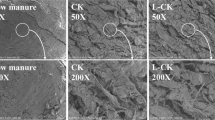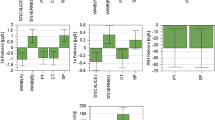Abstract
Heavy metals are of interest due to their deleterious impacts on both human and ecosystem health. This study investigated the effectiveness of wood ash in immobilizing the heavy metals Pb, Cd, Cu and Zn from aqueous solutions. The effects of initial metal concentrations, solution pH, ash dose and reaction time on metal sorption, as well as the metal sorption mechanisms were studied. To investigate the effect of initial metal concentrations, solutions containing Cd, Zn (25, 50, 75, 100 or 125 mg L−1), Cu (25, 50, 75, 100, 125, 150 or 175 mg L−1) or Pb (250, 500, 750, 1000, 1250, or 1500 mg L−1) were reacted with 10 g L−1 ash for two hours. For the effect of pH, solutions containing 100 mg L−1 of Cd, Cu or Zn or 1500 mg L−1 of Pb were reacted with 15 g L−1 ash over a pH range of 4 to 7. The wood ash was effective in immobilizing the four metals with a sorption range of 41–100 %. The amounts of metals retained by the ash followed the order of Pb > Cu > Cd > Zn. As expected, absolute metal retention increased with increasing initial metal concentrations, solution pH and ash dose. Metal retention by the ash exhibited a two-phase step: an initial rapid uptake of the metal followed by a period of relatively slow removal of metal from solution. Metal retention by the ash could be described by the Langmuir and Freundlich isotherms, with the latter providing a better fit for the data. Dissolution of calcite /gypsum minerals and precipitation of metal carbonate/sulfate like minerals were probably responsible for metal immobilization by the ash in addition to adsorption.
Similar content being viewed by others
References
Alloway, B. J. and Ayres, D. C.: 1993, Chemical principles of environmental pollution. Blackie Academic & Professional, London.
Baes, C. F. and Mesmer, R. E.: 1976, The hydrolysis of cations. John Wiley & Sons. New York.
Benjamin, M. M. and Leckie, J. O.: 1981, ‘Multiple-site adsorption of Cd, Cu, Zn and Pb on amorphous iron oxyhydroxide.’ J. Coll. Int. Sci. 79, 209–221.
Blanchard C., Manuanyl M. and Martin, G.: 1984. ‘Removal of heavy metals from waters by means of natural zeolites.’ Wat. Res. 18, 1501–1507.
Calace, N., Nardi, E., Petronio, B. M. and Pietroletti, M.: 2002. ‘Adsorption of phenols by papermill sludges.’ Environ. Pollut. 118, 315–319.
Chowdhurt, A. K., Stanforth, R. R. and Warren, R. S.: 1994, ‘In Situ Remediation of Contaminated Soil at a Lead-Acid Battery Cracking Site Using Phosphates’, I&EC special sumposium, Atlanta, GA, ACS.
Coughlin, B. R. and Stone, A. T.: 1995. Nonreversible adsorption of divalent metal ions (Mn, Co, Ni, Cu, and Pb onto goethite: effect of acidication, Fe (II) addition and picolinic acid addition. Environ. Sci. Technol. 29, 2445–55.
Denizli, A., Salih, B. and Piskin, E.: 1997. ‘New sorbents for removal of heavy metal ions: diamine-glow-discharge treated polyhydroxy ethylmethacrylate microspheres.’ J chromatography A. 773, 169–178.
Ferrero, F. and Prati, M. P. G.: 1986. ‘Coal fly ash alginate for the removal of heavy metals from aqueous solutions.’ Annali di Chimica 86:125–132.
Garcia-Sanchez, A. and Alvarez-Ayuso, E.: 2002. ‘Sorption of Zn, Cd, and Cr on calcite. Application to purification of industrial wastewaters.’ Min. Engin. 15, 539–547.
Hassett, D. J. and Eylands, K. E.: 1999, ‘Mercury capture on coal combustion fly ash.’ Fuel 78, 243–248.
Holm, T. R. and Zhu, X.: 1994. ‘Soption by kaolinite of Cd2+, Pb2+ and Cu2+ from landfill leachate-contaminated groundwater.’ J. Contam. Hydrol. 16, 271–287.
Jain, C. K. and Ram, D.: 1997. ‘Adsorption of lead and zinc on bed sediments of the river kali.’ Wat. Res. 31(1), 154–162.
Kinniburgh, D. G. 1986. ‘General purpose adsorption isotherms.’ Environ. Sci. Technol. 20, 895–904.
Ma, L. Q., Komar, K., Tu, C., Zhang, W., Cai Y. and Kennelly, E.: 2001. ‘A fern that hyperaccumulates arsenic: A hardy, versatile fast-growing plant helps remove arsenic from contaminated areas.’ Nature 409:579.
Ma, Q. Y., Traina, S. J., Logan, T. J. and Ryan, J. A.: 1993. ‘In situ Pb immobilization by apatite.’ Environ. Sci. Technol. 27, 1803–1810.
Ma, Q. Y., Logan, T. J., Traina, S. J.: 1995. ‘Lead immobilization from aqueous solutions and contaminated soils using phosphate rocks.’ Environ. Sci. Technol. 29, 1118–1126.
McBride, M. B. 1994. ‘Environmental Chemistry of Soils;’ Oxford University Press: Oxford.
McBride, M. B. 1979. ‘Chemisorption of cadmium on calcite surface.’ Soil Sci. Soc. Am. J. 44:26–28.
McConnell, D. 1973. ‘In. V. Herausgegeben (ed.) Applied Mineralogy. Apatite: its crystal chemistry, mineralogy, utilization, and geologic and biologic occurrences.’ New York, Springer-Verlag.
McGinnis G. 1995. ‘Wood ash in the Great lakes region: Production, characterization and regulation.’ Great lakes Regional Biomass Energy Program, Michigan.
Moller P. and Sastri, C. S.: 1973. ‘Exchange studies on single crystals of cacite using 45Ca as the tracer.’ Inog. Nucl. Chem. Lett. 9, 759–763.
Morse J. W. 1986. ‘The surface chemistry of calcium carbonate minerals in natural waters: An overview.’ Mar. Chem. 20, 91–112.
Namasivayam, C. and Kadiruellu, K.: 1997. ‘Agricultural solid wastes for the removal of heavy metals: Adsorption of Cu(II) by coirpith carbon.’ Chemosphere. 34(2), 377–399.
Namasivayam, C. and Ranganathan, K.: 1993. ‘Waste Fe(III)/Cr(III) sludge as adsorbent for the removal of Cr(VI) from aqueous solution and chromium plating industry wastewater.’ Environ. Pollution. 82, 255–261.
Periasamy, K. and Namasivayam, C.: 1996. ‘Removal of copper (II) by adsorption onto peanut hull carbon from water and copper plating industry wastewater.’ Chemosphere. 32, 769–789.
Rao, M., Parwate, A. V. and Bhole, A. G. 2002. ‘Removal of Cr and Ni from aqueous solution using bagasse and fly ash.’ Waste Manage. 22, 821–830.
Roy, W. R. 1993. ‘Sorption of cadmium and lead by clays from municipal incinerator ash-water suspensions.’ J. Environ. Qual. 22, 537–43.
Salt, D. E., Blaylock, M., Kumar, N. P. B. A., Dushenkov, V., Ensley, B. D., Chet, I. and Raskin, I.: 1995. ‘Phytoremediation: a novel strategy for the removal of toxic metals from the environment using plants.’ Biotechnology 13, 468–474.
Sims, R., Sorensen, D., Sims, J., McLean, J., Mahmood, R., Dupont, R., Jurinak, J. and Wagner, K.: 1986. ‘Contaminated surface soils in-place treatment techniques.’ Noyes Publications: Park Ridge.
Unger, Y. L. and Fernandes, I. J.: 1990. ‘Short-term effects of wood-ash amendment on forest soils.’ Water Air Soil. Pollut. 49, 315–328.
United States Environmental Protection Agency (USEPA). 2001. ‘Remediation technologies screening matrix, reference guide version 4.’ http://www.frtr.gov/matrix2/section4/4-29.html
Van Bladel, R., Halen, H. and Cloos, P.: 1993. ‘Calcium-Zinc and Calcium-Cadmium exchange in suspensions of various types of clays.’ Clay Miner. 28, 33–38.
Viraraghavan, T. and Rao, G. A. K.: 1991. ‘Removal of cadmium and chromium from wastewater using fly ash.’ 45th Purdue University industrial waste conference proceedings, Purdue University, Lewis Publishers, Inc.
Zachara, J. M., Cowan, C. E. and Resch, C. T.: 1991. ‘Sorption of divalent metals on calcite.’ Geochim. Cosm. Acta. 55, 1549–1562.
Zirino, A. and Yamamoto, S.: 1972. ‘A pH-dependent model for the chemical speciation of copper, zinc, cadmium and lead in seawater.’ Limnol. Oceanography. 17(5), 661–671.
Author information
Authors and Affiliations
Corresponding author
Rights and permissions
About this article
Cite this article
Chirenje, T., Ma, L.Q. & Lu, L. Retention of Cd, Cu, Pb and Zn by Wood Ash, Lime and Fume Dust. Water Air Soil Pollut 171, 301–314 (2006). https://doi.org/10.1007/s11270-005-9051-4
Received:
Accepted:
Published:
Issue Date:
DOI: https://doi.org/10.1007/s11270-005-9051-4




